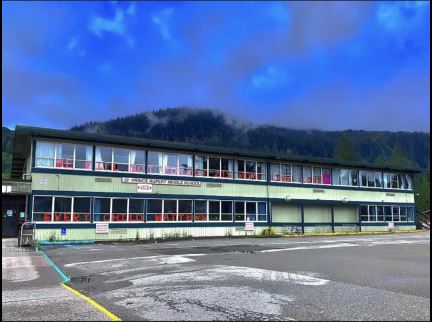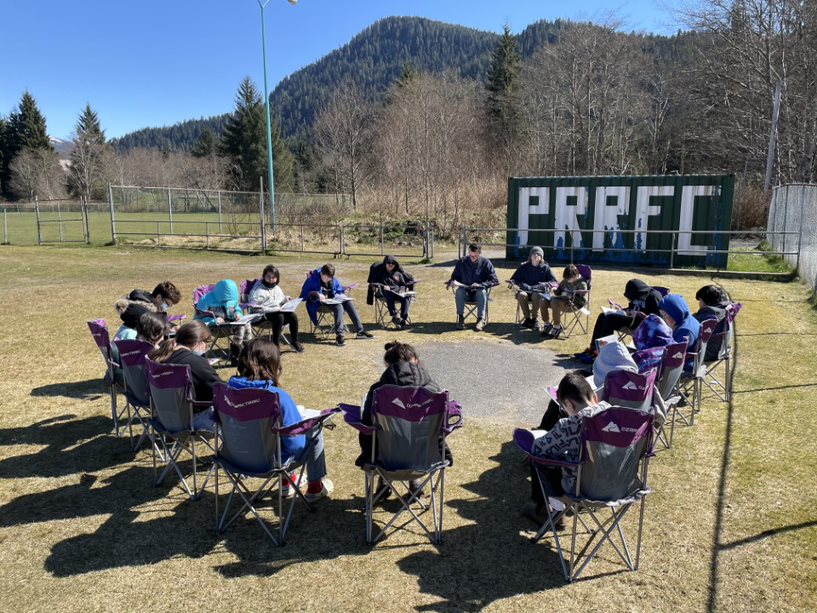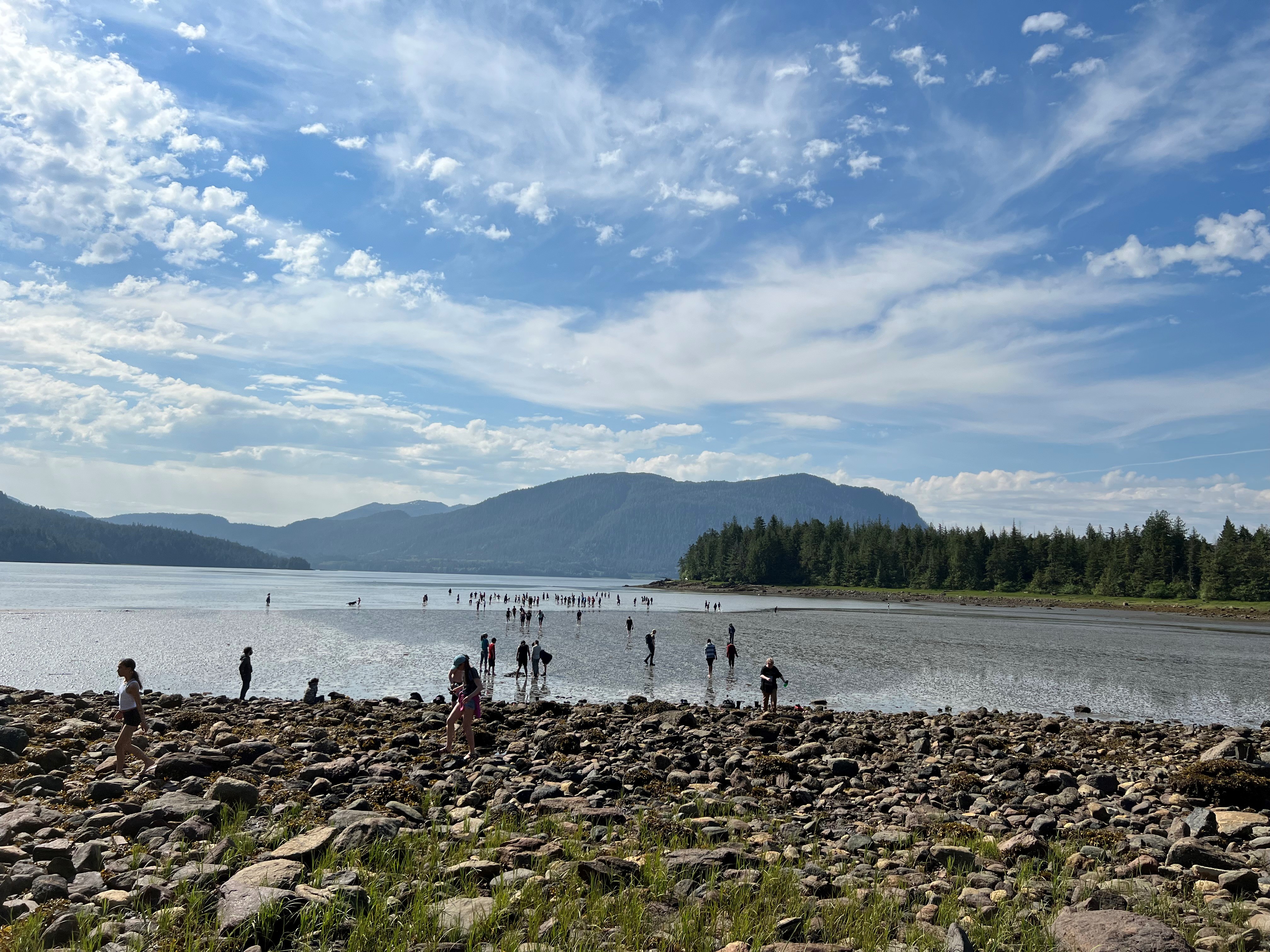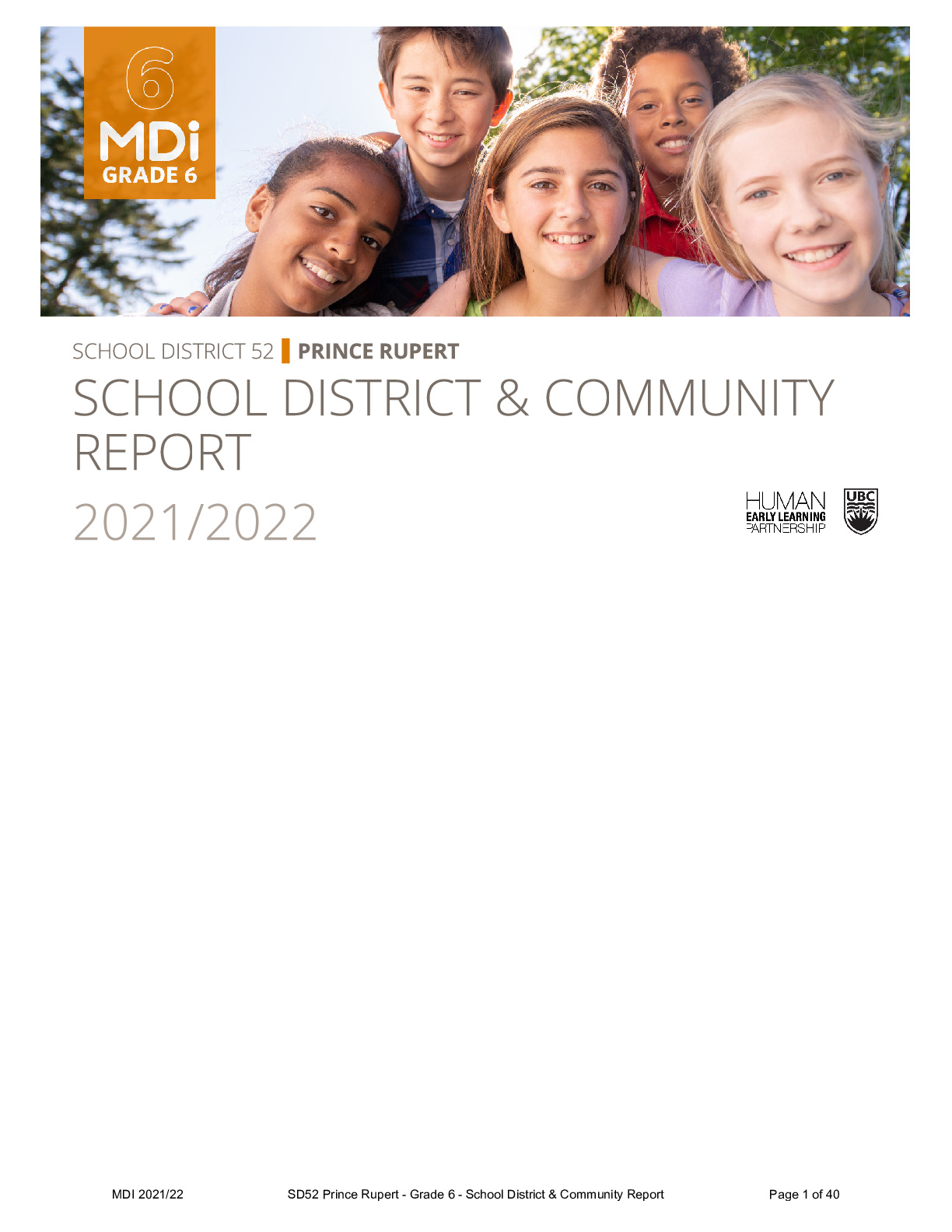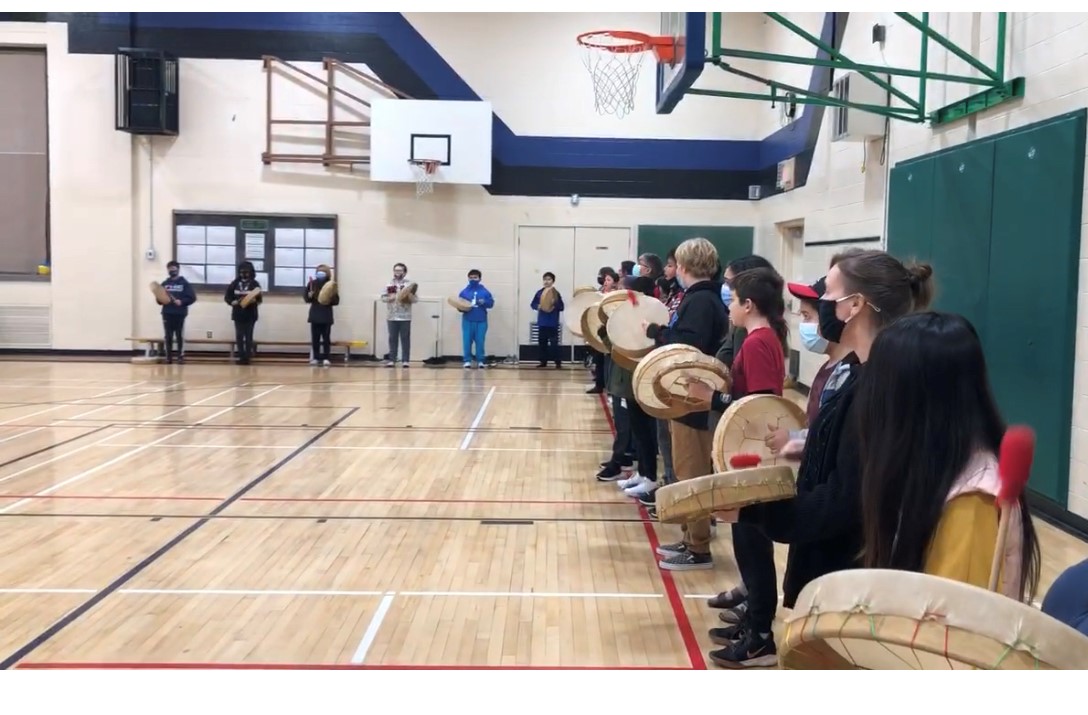![]() PRMS 2022
PRMS 2022
What are the important demographics of our community?
Our school, as well as our community has a 65% Indigenous population. We are located on the unceded territory of the Ts'msyen people, and we are very rich in culture and ethnicity. Our community is rich in indigenous culture, both Ts'msyen and Haida, and also has a large Asian population. We are located in a transition zone from a temperate rain forest to deciduous forest. Being part of the temperate rain forest means we experience a high amount of rainfall.
What are the unique, positive characteristics of the school?
Prince Rupert Middle School, (PRMS), is a grade 6,7,8 middle school located in Prince Rupert, B.C. PRMS is the one and only middle school in Prince Rupert. Students from five elementary schools feed into PRMS.
PRMS offers a full French Immersion Program as well as French as a second language and Sm'algyax language instruction. Teachers and staff at PRMS offer a variety of clubs, sports and activities and we are part of the After School Sports and Art Initiatives Program. Our teachers collaborate every Wednesday afternoon to plan various learning opportunities, projects and celebrations for our students. First Peoples' Principles of Learning and Indigenous Culture is embedded in our learning. Students take part in drumming, learning about totem poles, cedar, weaving, and role models. Prince Rupert is home to the annual All Native Basketball Tournament and PRMS boys and girls basketball teams are amazing. PRMS also runs a volleyball program, hockey academy and rugby program. We join with the high school for track and field, but have our own track and field day. PRMS offers six exploratory or elective courses each year. In addition to ADST, Cooking and Information Technology, we offer Textiles, Drama, Ukulele, and STORM, which is a class dedicated to teaching kids about resiliency and social emotional learning.
Outdoor education is an important part of PRMS. We are fortunate to be located next to a golf course and close to Mount Hays, the fish hatchery, and McClymont Park. When possible, classes are outside, not only for fitness, but to explore the environment. The Lester Centre for the Arts is also within walking distance. This is the largest Performing Arts Centre in the Northwest. PRMS attends the Lester Centre for school and district organized events. The PRMS band is able to practice and perform at the Lester Centre as well. We are also fortunate to have the arena and pool in our area and classes often go swimming and skating.
What are our assets - what do we celebrate (including student intellectual achievement)?
At PRMS we have many ways to celebrate our students. This year we have had many classes participating in daily walks, outdoor activities, forest hikes, community walks, place- based learning and project based, etc. We have had school events, such as a Medieval Fair, Hootenany, sports (basketball, volleyball, track), Ancient Civilization, grade group activities (Diana Lake, Butze Rapids, Amazing Race). We have a concert band and a jazz band. The band has travelled to Edmonton and performed at all the Elementary Schools, Acropolis Manor and our awards day.
We have a Hockey Academy that runs from September to Spring Break. Students in Hockey Academy are on ice three times a week and attend dryland sessions twice a week. Students also get in class sessions on Nutrition and Fitness.
PRMS offers many clubs throughout the year. We have Skittles, Minecraft, Kindness, Girls Power, Debate team, Drama, Power tech, and Doodle club.
We also celebrated with our Indigenous Education team. We have created a mural, weaving, drumming, devils club salve, devil club, harvested cedar, learned about feasting, local plants, totem poles, etc.
Each year we have an awards celebration and the coveted STORM award, each term we celebrate Effort Roll, Honour Roll and Principals' list at an assembly and at staff meeting we collect names for "students doing well' letters to be sent home. We celebrate living on Ts'ymsyen territory and experiencing the culture. Sm'algyax language classes have increased in enrollment yearly where students work on their knowledge of Indigenous language, culture and history.
Describe the overall strengths as well as the needs of the learners.
What is going on for them?
Prince Rupert has experienced many down turns in our economy over the past few years. Because of this we have many families living below the poverty line. Affordable and decent housing has been a struggle for many families. We have seen many students come to school hungry or tired,
Many of our families have experienced the effects of residential schools in the past. The school is not seen by all families as a safe place. We are working hard to recognize the impact that residentials schools has had on the families from our area and to build trust in the school by making it a welcoming place. We have two full time counsellors at PRMS. Our counselors work with classes, small groups and individuals. Our counselling services are used regularly by a large percentage of our students. Approximately 75% of our students access counselling services throughout the year.
The students at PRMS are in grade 6, 7, and 8 are in one of the most developmental periods of adolescents. To be successful with our students, a focus on relationship building, and building a students sense of belonging is just as important as academics. Part of learning for this age group is how to independently resolve peer conflicts, how to be responsible with social media, puberty, and healthy relationships.
As a district, we have a higher than average percentage of students with a designation. Many of our students need one to one support to access the curriculum.
What is the evidence that we already have that supports this hypothesis?
- School and district data, letter grades, attendance anecdotal, surveys, etc...DI, MDI, student voice such as TTFM, etc.
Which learners and which areas will we be focusing on?
What areas will we focus on to improve or enhance success for our learners based on what we know about them?
We want to focus on equity, literacy and math skills and build our commitment to Truth and Reconciliation. We want to focus on ways to have students take ownership of their learning. Literacy has always been one of our main goals. We feel by building relationships and having students take ownership of their learning, we will be more successful in reaching our literacy goals. We want to support our students through having a positive transition to PRMS in grade 6 and when the leave us in grade 9 (feast). We need to increase our outdoor activities, hands-on learning activities, project learning in all classrooms as well as continue to build trusting relationships and create a school that gives all students a sense of belonging that way students will be ready to learn. We will continue to follow the STORM (Safe, Trustworthy, Organized, Responsible, Mindful) Spirit Matrix so students know what is expected of them. We will use the Action School Mindfulness Calendar and help students self-regulate throughout the day. We also will increase students and reading skills by providing them with enjoyment while learning. Moving forward we will complete an equity scan at every staff meeting to determine which students are struggling academically, socially, or emotionally so that we can work towards supporting vulnerable students. We will also meet regularly with our Indigenous support workers and counsellors to help support our students.
Where are we connected?
- How does this focus connect to the district strategic plan? (Quote Strategic plan goal/objective #)
- How does this focus connect to the Aboriginal Education Enhancement Agreement? (Quote AEEA goal/objective)
- How does this focus connect to the redesigned curriculum including the big ideas, core competencies, curricular competencies, etc.?
-Our focus aligns with SD 52 Strategic Plan as there priorities are Equity, Truth and Reconciliation and Mental Health Literacy.
- Our focus connects to the Indigenous Education Partnership Agreement: Increase Indigenous learners achievement in reading and writing, increase Indigenous learners' achievement in math, increase Indigenous successful transitions, etc.
- Our focus connects to the redesigned curriculum including the big ideas, core competencies, and curricular competencies.
What is leading to this situation for our learners?
How might we be contributing to this?
We know that COVID- 19 has effects on all students.
We know that some families are struggling with issues at home and are finding it hard to get their children to school
From what we know, what is the most important work that we can do to improve the success for our students?
We need to provide a safe and welcoming environment for our students. We need to continue to use First Peoples Principles of Learning and worldviews. We need to increase supports for students that do not feel successful in the regular classroom. We need to provide more staff learning opportunities in Positive Behavior Support, Trauma Based Learning and Indigenous Education.
We need to start by focusing on student self-regulation, mindfulness and having a sense of belonging so that we can focus on increasing student achievement.
What key areas of learning will we focus on?
1) Focus on Equity. To create a sense of belonging, build strong relationships, and provide coping strategies for mental health issues for all students.
2) To have all students make progress in their Literacy and Numeracy levels by providing an enjoyment of learning.
3) Strengthen our commitment in Truth and Reconciliation by continuing to learn about Indigenous culture and history.
What are the actions that we propose to take related to our inquiry. What will we do more of, less of, differently to improve outcomes for our students?
We want to focus on equity, literacy and math skills and build our commitment to Truth and reconciliation.
We want to support our students through having a positive transition to PRMS in grade 6 and when the leave us in grade 9 (feast).
We need to increase our outdoor activities, hands-on learning activities, project learning in all classrooms.
-Continue to build trusting relationships and create a school that gives all students a sense of belonging that way students will be ready to learn.
-We will continue to follow the STORM (Safe, Trustworthy, Organized, Responsible, Mindful) Spirit Matrix so students know what is expected of them.
-We will use the Action School Mindfulness Calendar
-Help students self-regulate throughout the day
-We also will increase students and reading skills by providing them with enjoyment while learning.
-Meet regularly to make sure all students are on track
-Continue to provide opportunities for staff to learn about PBIS, Trauma Informed Practice and Indigenous Education
How can we break it down into a manageable and realistic 3 year plan:
Year 1:Develop our plan, determine our needs, look into resources
Year 2: Action: Creating and implementing equity scans and increasing staff professional development on Indigenous Education, Trauma Informed Practice , Mental Health, and PBIS
Year 3: Assessing our plan and making necessary modification and determine our next steps
Summarize what the new areas of learning will be and how we will support that new learning in order to benefit the students (i.e. resources, pro-d, etc.).
1) Equity- continue learning in trauma informed practice, provide support for relationship building, continue to learn about positive behavior support, continue with using First Peoples' Principles of teaching and worldviews, continue learning about Pride based activities, encourage learning in project based, outdoor education, place-based learning. Increase mindfulness and self regulation activities.
2) Literacy and Numeracy- Collaboration with other teachers, professional development (Carole Fullerton, Adrienne Gear, Nancy Young), provide enjoyment in reading and math activities.
3) Truth and Reconciliation: Continue the Partnership learning from our Indigenous Education department, attend Professional Development workshops, attend books club, learning about the Calls to Actions and the Declaration on the Rights of Indigenous People Act Action Plan (DRIPA).
Link these new areas of learning to the redesigned curriculum
How will we know that what we are doing is working and is making a difference for our learners?
What evidence of learning will we collect to check the progress on our goals?
If we are making a difference in equity we will see an increase in positive behavior (students helping each other, being respectful towards others, happy students, etc.) for all students. We will continue to check our attendance rates and hopefully see more students attending on a regular basis. We will do Assessments- Reading Assessment (6 minute solution, benchmarks, etc). Our Enhancing Students Learning Survey will provide us with details on how the students are feeling about the enjoyment of reading and math. In addition, teachers can also provide anecdotal comments on student engagement. If more students are feeling supported we should have less office referrals. if students are feeling safe and a sense of belonging we will see an increase on our FSA (Foundational Skills Assessments) and an increase of report cards marks (honour roll, effort roll, and principal's list).
We would also like to see and increase of attendance at our Family night activities.
What will we be using as baseline data? How will we chart growth?
- Improved attendance
-improved literacy and numeracy results
-more family involvement
-compare our results from Framework survey year to year
-less office referrals
-less parent complaints
How will we respond if we see no changes?
How will we make parents, students and other members of the community aware and involved?
How will we share our plan with staff?
We will share our plan with our teachers so that they can add to and modify the plan as the year progresses. We will look at this plan at our team leader meetings and they can share it with their grade groups.
How will we share our goals with students?
We will create a powerpoint and share it with students at our Grade Group Assemblies.
How will we share our goals and progress with parents?
We will provide a link of this plan in our newsletters and on our website so that parents/guardians can view it. We will also share at our PAC meetings and any Parent/guardians gatherings. We will also have a copy available at school on our parent/guardian bulletin board.
Include numbers of students, grade levels, etc.
Prince Rupert Middle School has 439 students in grade 6, 7 and 8 in age range from 10-14. 284 students or 65% of which are Indigenous heritage. There are 97 grade 6, 95 grade 7 and 92 grade 8 Indigenous Learners.
List examples of pro-d, special events, speakers, curricular integration, routines and customs, etc.
Things we have done in the past year that will build on our goals:
- STORM Spirit Matrix and expectations taught to all students
-School Spirit Days: Sports Wear Day, Dress like a Teacher, Red/Green Day, Toque/Scarf Day, Pajama Days, Hawaiian Shirt Day, Twin Day, Etc.
-Indigenous Events: Orange Shirt Day and Reconciliation Walk, National Indigenous Day, Drumming, Cedar harvesting, forest walks, devils club salve, weaving, etc.
- Professional Development: Literacy (Adrienne Gear, Science of Reading) Math (Carole Fullerton)
- Indigenous Education workshops (Celebrating Indigenous Brillance with Jo Chrona, Bob Joseph, Carolyn Roberts, Harvesting Cedar, Sm'algyax learning, Drum Making, Seasonal Rounds, Outdoor Education, Witness blanket, Brad Marsden Fire Across the Land, Book Club: Unreconciled, Advancing Reconciliation Education, etc.)
List continuing and new initiatives
- Continue learning about Truth and Reconciliation
-Continue learning in Trauma Informed Practice
- Continue learning in Positive Behavior Support and create a school based team
- Continue partnership with Indigenous Education
-Increase learning and opportunities in Pride Based activities
- Increase place based and outdoor education learning
- Increase project based learning
- Continue collaboration
- Continue with mindfulness activities
-Increase self-regulation activities
Include both data-driven and anecdotal examples
-Increase attendance rates will show we are successful
- Improvements in literacy and numeracy scores will show we are being successful
-Teacher anecdotal comments on student engagement and staying in class
-Less office referrals
Give opportunities for student, staff and parent voice
We would like to increase opportunities for our families to come into the school for activities not related to students academic progress. In doing so, we hope to increase family support and trust in the school.
We would like to have the opportunity at each staff meeting to do activities based on PBIS, Trauma Informed Practice, Equity Scan, Indigenous Education and give staff time to share what is working and where they might need support.
We will share our Growth Plan at regular PAC meetings and on our website to encourage parent voice.
Student voice can be gathered in several ways through discussions with counsellors, EA's, teachers, administration and through the Framework survey.
